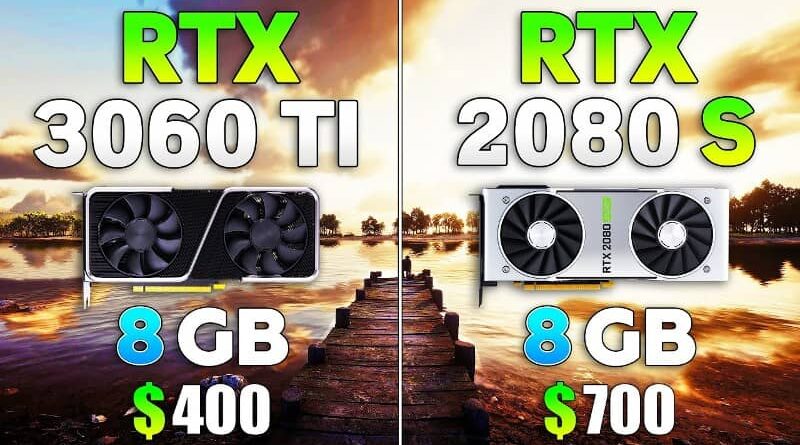
NVIDIA has consistently been at the cutting edge of technological advancement and performance in graphics cards. The GeForce 3060 Ti and the GeForce 2080 Super are two popular options in their lineup. These GPUs are known for their impressive capabilities and are sought after by gamers and content creators.
One of NVIDIA’s best consumer graphics cards from the previous generation is the GeForce RTX 2080 Super, whereas one of their latest mid-range GPUs is the 3060 Ti. The performance of these graphics cards is comparable, though, thanks to advancements in technology between GPU generations.
Watch this video to know if it necessarily means you ought to purchase the more recent card. Or does the older version still possess any vigor?
In this article, we will compare the 3060 Ti vs 2080 Super in various aspects to help you decide when to upgrade your next graphics card.
Overview of the GeForce 3060 Ti and GeForce 2080 Super
The GeForce 3060 Ti is part of NVIDIA’s latest RTX 30 series lineup based on the Ampere architecture. It offers impressive performance at a more affordable price than the higher-end RTX 30 series cards.
With features like D.L.S.S. (Deep Learning Super Sampling) and ray tracing, the 3060 Ti can deliver stunning visuals and smooth gameplay.
On the other hand, the GeForce 2080 Super belongs to the previous generation of NVIDIA’s graphics cards, namely the RTX 20 series.
It still holds its ground as a capable high-end GPU with ray tracing capabilities and excellent performance for demanding gaming and content creation tasks.
Performance Comparison
Frame Rates and Gaming Experience
In terms of gaming performance, both GPUs deliver impressive results. At 1080p and 1440p resolutions, the 3060 Ti runs remarkably well, offering fluid gameplay even in titles with demanding graphics.
While the 3060 Ti has somewhat more power, the 2080 Super, an advanced card from the previous generation of cards, performs just as well in most games.
Ray Tracing Capabilities
Ray tracing is one of the unique characteristics of NVIDIA’s RTX series graphics cards. This technique makes illumination, shadows, and reflections more realistic in games that use it.
Both support ray tracing, but the 3060 Ti benefits from improved ray tracing performance thanks to the advancements in the Ampere architecture.
Power Consumption and Efficiency
When it comes to power consumption, the 3060 Ti is more power-efficient compared to the 2080 Super. The Ampere architecture introduced significant improvements in power efficiency, allowing the 3060 Ti to deliver impressive performance without drawing excessive amounts of power.
This can benefit users who prioritize lower energy consumption and cooler operating temperatures.
Features and Technologies
NVIDIA DLSS (Deep Learning Super Sampling)
DLSS is a feature exclusive to NVIDIA RTX series graphics cards. It utilizes A.I. and machine learning to upscale lower-resolution images in real-time, providing smoother visuals without significantly impacting performance.
The 3060 Ti and 2080 Super support D.L.S.S., allowing for enhanced graphics and improved frame rates in supported games.
V.R. (Virtual Reality) Support
Virtual Reality gaming and experiences are becoming increasingly popular, and both cards provide ample performance for V.R. applications. They are adept at handling V.R. games and applications, offering a seamless and lifelike virtual reality experience.
Real-World Performance and Gaming Benchmarks
Popular A.A.A. Games Performance Comparison
In popular A.A.A. games like “Cyberpunk 2077,” “Assassin’s Creed Valhalla,” and “Call of Duty: Warzone,” both the 3060 Ti and 2080 Super offer excellent performance.
While the 3060 Ti may have a slight edge in terms of raw power, the 2080 Super remains a capable option for smooth and immersive gaming experiences.
1440p and 4K Gaming Experience
At 1440p resolution, both the 3060 Ti and 2080 Super deliver exceptional performance, allowing for high frame rates and excellent visuals in most games.
Regarding 4K gaming, the 2080 Super shows its strength, offering better performance than the 3060 Ti.
However, it’s worth noting that both cards may require some settings adjustments to achieve consistent 60fps gameplay in graphically demanding titles at 4K.
Content Creation and Workstation Performance
Graphics cards are crucial for gaming and play a significant role in content creation and workstation tasks. Let’s explore how the 3060 Ti and 2080 Super perform in these areas.
Rendering and Video Editing Benchmarks
When it comes to rendering tasks in applications like Blender, Autodesk Maya, and Adobe Premiere Pro, both the 3060 Ti and 2080 Super provide excellent performance.
They can handle complex scenes and high-resolution videos without significant slowdowns, allowing efficient content creation workflows.
Machine Learning and A.I. Applications
With the rise of machine learning and AI, graphics cards have become essential for accelerating these tasks. The 3060 Ti and 2080 Super excel in machine learning applications, thanks to their C.U.D.A. and dedicated tensor cores.
Whether you’re training neural networks or running AI-based algorithms, both cards offer great performance for these workloads.
Availability and Pricing
When comparing prices, the 3060 Ti is typically less expensive than the 2080 Super while generally providing comparable or superior performance. It offers an appealing alternative for gamers and video producers seeking an equilibrium between capability and affordability.
Pros and Cons
Let’s examine the advantages and disadvantages of both these NVIDIA GPUs to summarise each graphics card’s strengths and limitations.
Pros of the GeForce 3060 Ti:
- Advanced ray tracing performance
- D.L.S.S. support for enhanced visuals and performance
- Power-efficient and cooler operation
- Availability in the market
Cons of the GeForce 3060 Ti:
- Lower performance compared to higher-end RTX 30 series cards
- Limited VRAM capacity for specific professional applications
- Availability may vary in some regions
Pros of the GeForce 2080 Super:
- High-end performance for demanding games and applications
- Ray tracing capabilities
- Solid 4K gaming performance
- Ample C.U.D.A. cores for content creation tasks
- VR-ready for immersive virtual reality experiences
Cons of the GeForce 2080 Super:
- Higher power consumption compared to the 3060 Ti
- Previous generation card with potential availability limitations
- Less price-to-performance value compared to the 3060 Ti
Conclusion
The GeForce 2080 Super and 3060 Ti are potent graphics cards, each with unique advantages. The 3060 Ti is an appealing option for gamers and video producers on a tight budget because it has an excellent price-to-performance ratio.
It provides better ray tracing performance and high efficiency and excels in 1080p and 1440p gameplay. However, the 2080 Super is a top-tier choice, especially for 4K gaming and labor-intensive content creation activities.
The decision between the two will ultimately be based on your unique requirements, financial situation, and availability.
Consider your intended gaming or working resolution, the system requirements for your preferred programs, and your available spending power. Both options can deliver impressive results for gaming and content creation enthusiasts.
Frequently Asked Questions
1. Is the GeForce 3060 Ti better than the 2080 Super?
In terms of raw performance and efficiency, the 3060 Ti has the edge over the 2080 Super. However, the 2080 Super may perform better in some 4K gaming scenarios.
2. Can the GeForce 3060 Ti run ray-tracing games?
The 3060 Ti supports ray tracing technology and can run ray tracing games. It provides improved ray tracing performance compared to the 2080 Super.
3. Which graphics card is better for content creation?
Both the 3060 Ti and 2080 Super are capable options for content creation.
The 2080 Super may be slightly advantageous due to its higher C.U.D.A. core count and VRAM capacity.


